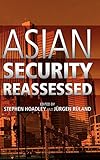Asian Security Reassessed / ed. by Stephen Hoadley, Jurgen Ruland.
Material type: TextPublisher: Singapore : ISEAS Publishing, [2006]Copyright date: ©2006Description: 1 online resource (400 p.)Content type:
TextPublisher: Singapore : ISEAS Publishing, [2006]Copyright date: ©2006Description: 1 online resource (400 p.)Content type: - 9789812304001
- 9789812307101
- 355.03305 23
- UA830 .A8564 2006
- online - DeGruyter
| Item type | Current library | Call number | URL | Status | Notes | Barcode | |
|---|---|---|---|---|---|---|---|
 eBook
eBook
|
Biblioteca "Angelicum" Pont. Univ. S.Tommaso d'Aquino Nuvola online | online - DeGruyter (Browse shelf(Opens below)) | Online access | Not for loan (Accesso limitato) | Accesso per gli utenti autorizzati / Access for authorized users | (dgr)9789812307101 |
Frontmatter -- Contents -- Acknowledgements -- About the Contributors -- List of Abbreviations -- Preface -- Part One. Approaches to Asian Security -- 1. The Evolution of Security Thinking: An Overview -- Part Two. Security Management by Asian States and Regional Institutions -- 2. Asia from Colonialism to Culturalism -- 3. Japan and East Asian Regional Security -- 4. China’s Security Strategy and Policies -- 5. United States Security Policies in Asia -- 6. Regional Security Institutions: ASEAN, ARF, SCO and KEDO -- Part Three. Non-Traditional Challenges to Asian Security -- 7. Weapons Proliferation in Asia -- 8. Conflicts over Natural Resources and the Environment -- 9. Ethnic Conflict, Separatism and Terrorism -- 10. Irregular Migration as a Security Issue -- 11. Globalization and Asian Financial Insecurity -- 12. Challenges to Human Rights and Civil Liberties -- Part Four. New Concepts of Asian Security -- 13. Asian Security as a Global Public Good -- 14. Communities and Security in Pacific Asia -- 15. Traditionalism and Change in the Asian Security Discourse -- Index
restricted access online access with authorization star
http://purl.org/coar/access_right/c_16ec
This book traces changes in the concept of security in Asia from realist to cooperative, comprehensive, and human security approaches, and assesses a number of policy alternatives to management of both old and new security threats. It surveys not only orthodox security threats such as tensions between regional powers or armed ethnic antagonists but also new sources of anxiety such as resource scarcity, economic instability, irregular migration, community fragmentation, and international terrorism. Security policies of major powers such as China, Japan, and the United States, and the moderating roles of regional organizations such as ASEAN, ARF, SCO, and KEDO are evaluated in historical and contemporary perspectives. Contributors proffer policy-relevant insights where appropriate. The book concludes that traditional security approaches remain valid but need to be adapted to the new challenges, and offers suggestions for incorporating fresh Asian security perceptions into the agendas of policy-makers, analysts, and scholars.
Mode of access: Internet via World Wide Web.
In English.
Description based on online resource; title from PDF title page (publisher's Web site, viewed 01. Dez 2022)


